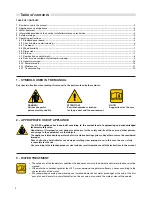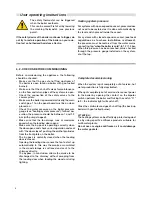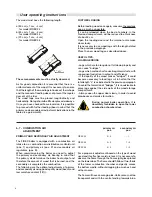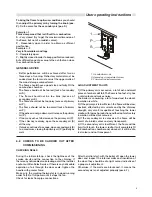
9
User operating instructions
1
P
S
To bring the fl ame to optimum conditions
you should
then
adjust the primary air by turning the knob (pos.
P)
. Do the same
for the secondary air (pos. S)
.
Example n.1
Thick damp wood that is diffi cult for combustion
S - Very closed (try to get the maximum dimension of
the fl ame, but not of a reddish colour).
P - Reasonably open in order to obtain a suffi cient
gasifi cation.
Example n. 2
Very infl ammable wood logs
S - Completely open.
P - Slightly closed in order to keep gasifi cation reduced,
but suffi ciently open to evacuate the ash that can close
the combustion head.
GENERAL ADVICE
- Better performance will be achieved after two or
three days of running. Refractory material must be
cooked and the tar must encrust the upper walls of
the wood storage compartment.
- The
fl ame should have a good size and fairly fi ll the
combustion chamber.
- The
fl ame should not be too red (lack of secondary
air S).
- The flame should not be too blue (excess of
secondary air S).
- The
fl ame should not be too noisy (excess of primary
air P).
- The fl ame should not be too small (lack of primary
air P).
- If the ashes do not go down well, increase the primary
air (P).
- If too many ashes fall, decrease the primary air (P).
- If the chimney is smoky, open the secondary air (S)
all the way.
- If smoke continues to escape, open secondary air (S)
to a maximum, closing the primary air (P) partially as
well.
6.8 CHECKS TO BE CARRIED OUT AFTER
COMMISSIONING
CHECKING SEALS
During the initial start-up, check the tightness of the
smoke circuit and the connection to the chimney. If
there is any noticeable smoke leakage, alert the installer
and/or our After-Sales Service. If there is any noticeable
aspiration of air through the door seals, tighten the
handle with greater force.
Make sure the working thermostat is in good running
order Te (32) at full power until it stops the fan.
Check for leaks from pipe connections.
1 Air adjustment unit
S Secondary air adjustment screw
P Primary air adjustment screw
AIR ADJUSTMENT FAULTS
1) If the primary air is excessive, a lot of ash and small
pieces of embers will fall. The fl ame is too fast, dry, has
a cold colour and makes noise.
The boiler is consuming a lot of wood and the door’s
insulation is white.
2) If the primary air is insuffi cient, the fl ame will be slow,
hesitant, affected by air currents and by the chimney
draught, very small, incapable of touching the lower
cradle, with low ash production and the door’s refractory
insulation will be dark coloured.
3) If the secondary air is excessive. the fl ame will be
small, of a bluish colour and very transparent.
4) If the secondary air is insuffi cient. the fl ame will be
big, it will touch the lower cradle, it will completely fi ll
the combustion chamber and, above all, it will be of a
red colour and not transparent.
After the initial start, with the boiler off, open the lower
door and inspect the internal walls and insulation of
the door: they should be of a light colour, indicative of
a proper air adjustment.
Otherwise, if the walls are blackened, it means the
secondary air is not adjusted properly (par. 6.7).






























